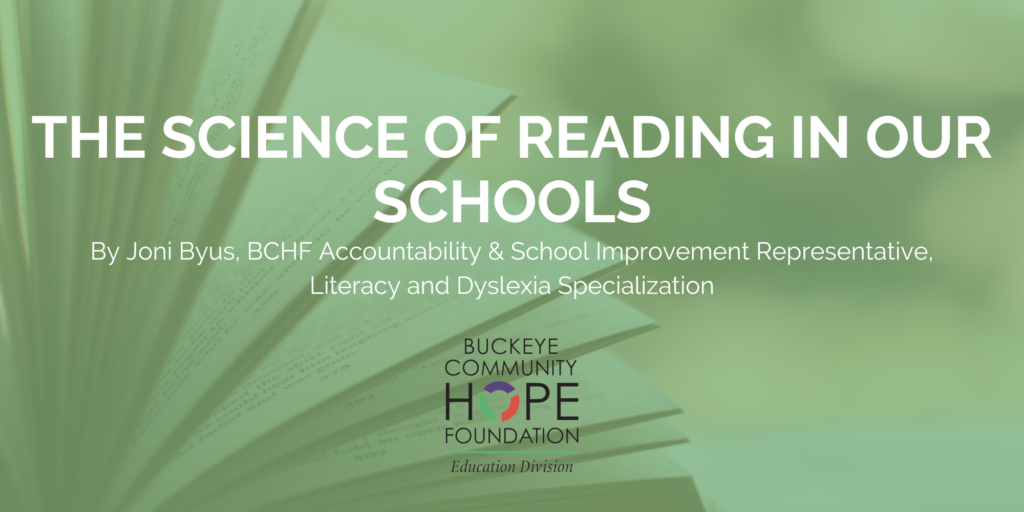| By Joni Byus, BCHF Accountability & School Improvement Representative, Literacy and Dyslexia Specialization On July 4, 2023, during the Ohio 135th General Assembly, House Bill 33 was passed with an effective date of October 3, 2023. Among other things, HB 33 mandated a shift in school curriculum, teacher training, and reading intervention approaches in the State of Ohio to align to the Science of Reading (SoR). In doing so, Ohio joined about 32 states, all of whom have legislatively prescribed Science of Reading instruction in their public schools. The requirements of HB 33 for the Department of Education and Workforce include the establishment of a list of core curriculum and instructional materials in English Language Arts (including reading); a list of evidence-based reading intervention programs aligned with SoR; and use of evidence-based strategies for effective literacy instruction. The mandate also requires all teachers and administrators to complete training in the SoR and evidence-based literacy instruction by June 30, 2025. What is the Science of Reading (SoR)? According to the Ohio Department of Education (2023) Science of Reading (SoR) is defined as: 1. (SoR) is “a body of research that incorporates insights and research from disciplines that include developmental psychology, educational psychology, cognitive science, and cognitive neuroscience. The science of reading specifies what evidence-based practices enable students to learn to read. 2. The body of SoR research:a. Informs how students learn to read and write proficiently.b. Explains why some students have difficulty with reading and writing.c. Indicates that all students benefit from explicit and systematic instruction in phonemic awareness, phonics, vocabulary, fluency, comprehension, and writing to become effective readers.d. (Ensures instruction) Does not rely on any model of teaching students to read based on meaning, structure and syntax, and visual cues, including a three-cueing approach.” What does instruction to the Science of Reading look like? The National Reading Panel report in 2000 listed five components that are essential for students to become proficient readers. These components are phonemic awareness, phonics, fluency, vocabulary, and comprehension. The NRP (2000) defines these components, as follows: Phonemic Awareness – recognizing that words are composed of individual sounds (blended for reading; pulled-apart for spelling) Phonics – method of teaching students to connect relationships between phonemes (sounds) and graphemes (letters/spelling) Fluency – reading text with sufficient speed and accuracy to support comprehension. This includes: reading accuracy, reading rate, and reading expression. Vocabulary – understanding individual word meanings in a text. Should be developed through direct and indirect instruction. Comprehension – understanding of connected texts. This is the ultimate goal of reading. Science of Reading (SoR) initiatives revisit these components but in a manner that emphasizes “code-based instruction,” placing phoneme awareness and phonics at the forefront of learning to read. Scarborough’s Reading Rope (2001) is a wonderful visual about how the sum of these parts works to develop strong readers, and that the strength is affected when one part is missing. SCARBOROUGH’S READING ROPE |
 |
| Key Points Some key things to know about SoR: • SoR applies to ALL students. • Teaching reading doesn’t have to be complicated. • Teachers need training to implement structured literacy approaches aligned to SoR. What will schools need to do? All schools will need to: • Develop a plan to transition fully to the Science of Reading for instruction. The Department offers a planning guide for schools entitled Shifting to the Science of Reading available on the website at: Shifting to the Science of Reading: A Discussion Guide for School and District Teams (ohio.gov) • As of the 2024-25 school year, use core reading curriculum and instructional materials from the lists established by the Department of Education and Workforce ODE(DEW). DEW is to make these lists available in the second semester of 2023-24. • Align reading interventions with SoR and evidence-based practices. • Train teachers. Currently, ODE(DEW) offers a 45-minute course online as well as several other resources. Course link: The Science of Reading | Ohio Department of Education BCHF is available to provide technical assistance to schools as we journey through this process together. To discuss or arrange technical assistance with BCHF on this topic, please feel free to reach out to Joni Byus: jbyus@buckeyehope.org References and Resources: Blevins, W. (2017). A fresh look at phonics, Grades K-2: Common causes of failure and 7 ingredients for success. Thousand Oaks, CA: Corwin Literacy. Ohio Department of Education (2023). The science of reading. Retrieved from The Science of Reading | Ohio Department of Education. Jiban, C. (2023). What the science of reading tells us. Retrieved from https://www.nwea.org/blog/author/cjiban/ Scarborough, Hollis (2001). Connecting early language and literacy to later reading (dis)abilities: Evidence, theory, and practice. In Neuman, Susan B (ed.). Handbook of early literacy research. Guilford Press. pp. 23–39. |

